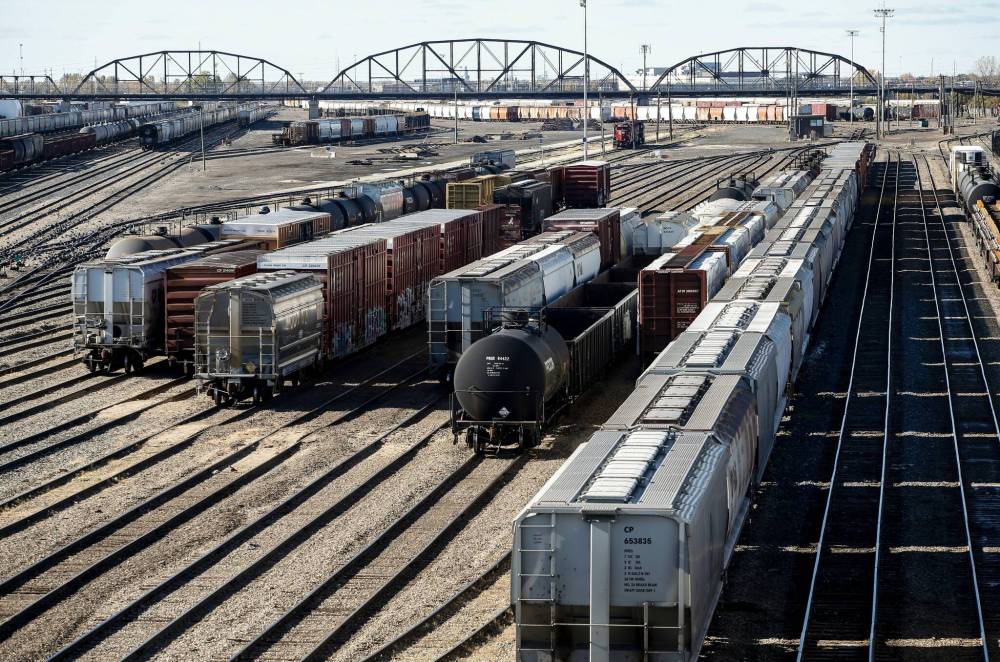The NDP government has retained former federal cabinet minister Lloyd Axworthy to lead an ambitious, two-year study into the relocation of rail lines and yards that currently occupy high-value property in Winnipeg’s core, the Free Press has learned.
Sources confirmed Premier Wab Kinew will announce Axworthy’s appointment on Tuesday. It’s expected Kinew will indicate at an event that Axworthy has been asked to “engage” with the federal government and railways on the prospects for relocation, the sources added.
It is believed the federal government would need to be a major funding partner for a relocation plan to come to fruition. Ottawa has provided significant support for rail-line relocation in other cities, including Edmonton and Regina.

The Axworthy-led study breathes new life into a pledge first made in 2016 by then-NDP premier Greg Selinger. Selinger committed $400,000 for a feasibility study and had gone as far as retaining former Quebec premier Jean Charest to helm the initiative.
Kinew signalled his interest in reviving a relocation study in a December 2023 year-end interview with the Free Press. At that time, Kinew said he had already spoken to Winnipeg Mayor Scott Gillingham and federal Northern Affairs Minister Dan Vandal, the MP for Saint-Boniface-Saint Vital, to gauge their support.
Kinew followed up those comments in the April 2024 budget with a commitment of $200,000 for a study that would look at “the feasibility and possible timelines for relocating the rail lines and whether the relocation can be done incrementally. A relocation of the rail lines would move large rail yards that serve as barriers between neighbourhoods and potentially increase safety as hazardous materials would no longer be transported through residential areas.”
The sources confirmed that while the major rail lines and yards downtown will be a major focus, smaller spur lines throughout the city will also be up for relocation.
Axworthy, formerly the senior federal cabinet minister for Manitoba, has long been a supporter of rail line relocation and was quick to support the plan floated by Selinger in 2016.
Following the 2016 election, which the NDP lost handily, incoming Tory premier Brian Pallister demonstrated no interest in an ambitious plan that some have estimated would cost more than $1 billion. Within a few months of defeating the NDP, Pallister cancelled the study and dashed any hope that the lines and yards that bisect north and south Winnipeg could ever be relocated.
Relocation was flagged again in early 2023 following a train derailment in Winnipeg’s north end. Several cars carrying bitumen derailed near a rail overpass that crosses McPhillips Street, one of Winnipeg’s busiest commuter routes.
Then-premier Heather Stefanson said despite the fact there were no injuries, the derailment had revived some modest interest in rail line relocation. She did not, however, commission a study or pursue the issue any further and went on to lose the general election held last fall.

The city has remained actively interested in relocation. The city released a new planning document in the summer — CentrePlan 2050 — which seeks to re-imagine the development of downtown to make it more welcoming and walkable. It was quickly dubbed as the Core Area Initiative 2.0, a nod to the extremely successful, tripartite downtown redevelopment initiative started in the 1980s.
Although rail relocation was not highlighted as a major priority for the CentrePlan 2050, many observers, including Axworthy, said at the time that it should be added to the agenda for future development.
In 2019, Axworthy collaborated with Harry Finnegan, a former head of the city’s property and development department, to write a commentary published in the Free Press urging politicians at all levels of government to get back on board the rail relocation dream.
At that time, Axworthy and Finnegan noted that although relocation was an expensive proposition, it could actually save the city billions of dollars in the long run. For example, the relocation of rail lines and the Canadian Pacific Railways yards in downtown Winnipeg would relieve the city of the need to rebuild the Arlington Bridge at an estimated cost of more than $200 million.
Axworthy and Finnegan also noted that the rail industry has changed dramatically. Many of the goods needed by businesses within the city are now handled by trucks or airplanes, they argued. As a result, railways have fewer customers within city limits as they focus more on moving commodities like bitumen and grain.
dan.lett@winnipegfreepress.com

Dan Lett
Columnist
Dan Lett is a columnist for the Free Press, providing opinion and commentary on politics in Winnipeg and beyond. Born and raised in Toronto, Dan joined the Free Press in 1986. Read more about Dan.
Dan’s columns are built on facts and reactions, but offer his personal views through arguments and analysis. The Free Press’ editing team reviews Dan’s columns before they are posted online or published in print — part of the our tradition, since 1872, of producing reliable independent journalism. Read more about Free Press’s history and mandate, and learn how our newsroom operates.
Our newsroom depends on a growing audience of readers to power our journalism. If you are not a paid reader, please consider becoming a subscriber.
Our newsroom depends on its audience of readers to power our journalism. Thank you for your support.